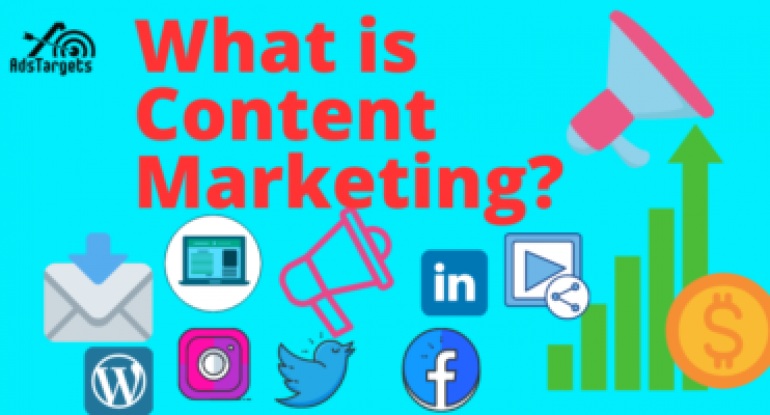You might have heard much about content marketing and how its effectiveness can help take your business to the next level. However, you may not understand how to exactly go about it.
It’s very easy to explain to a newbie what this marketing strategy is all about but the difficulty might come with how to actually go about it.
Before going deep into the topic, here is what you need to know to have a clear understanding of what content marketing is all about.
Content marketing is the branch of marketing that includes a set of techniques to create and share relevant and valuable textual and visual content around a brand or product/service, so as to create an engagement that also guides the purchasing process of users.
Table of Contents
ToggleHow to build an effective content strategy
The set of techniques for creating and sharing relevant textual and visual content around a brand or product: this is how content marketing can be briefly defined.
#1. The first step to building an effective strategy is planning, which includes identifying a business case or a simple mission on which the entire plan is to be built.
#2. It is then necessary to clarify what are the differentiating factors of the company’s products or services, the expectations in terms of redemption, the consistency with respect to the digital marketing plan.
#3. last but not least, a thorough understanding of the company is required: who we are, where we are and where we want to go.
The second factor to take into consideration is the reference audience, possibly distinct (and segmented) into two macro-categories:
On the one hand the stakeholders, on the other the reference market, with all the appropriate considerations on the type of users/customers to be involved.

The identification of one or more types of person, the socio-demographic segmentation and the corresponding differentiations of needs and expectations.
From this perspective, the link between content marketing and the study and analysis of buyer personas is perfectly understood.
Once the plan and audience have been defined, we move on to history, understood in the broadest sense of the term.
It is the idea on which the entire content promotion plan is developed, the principle on which to differentiate the experience of potential customers and achieve a distinctive positioning on the market.
There is no univocal narrative rule nor the reference to the term “story” must necessarily suggest a beginning and an end.
The storytelling element is essential for building a bond of involvement with the target audience and identifying the right key to interpreting a story capable of expressing the challenges, passions and identity of a company.
Only with a compelling and engaging story can you get an effective content plan.
A story must be accompanied by the right means, and consistent with the marketing objectives and the editorial plan.
For this reason, the next step after storytelling is the identification of the most effective means to disseminate one’s content and involve the target market.
It is not a question of identifying a single communication channel but of finding the solutions that best suit the expectations and needs of the public to be involved.
Creating a content marketing strategy, and identifying target segments and channels necessarily imply the creation of a real process, in which every single phase is appropriately assessed, monitored and assigned to specific business sectors or functions.
Content Strategist: Who it is and What it does
The content strategist is a professional figure who supervises and harmonizes all the activities that have to do with the creation of brand content or that are also part of the corporate editorial plan.
And, indeed, with companies from all sectors allocating ever more substantial investments in content marketing, the content specialist is now one of the most sought-after new digital professions.
More than other figures, even similar ones, such as that of the content editor, for example, a good content specialist is equipped with technical skills, soft skills, and strategic vision that helps to make the content suitable for achieving business objectives such as increasing traffic.
Organic referral to the site, the acquisition of inbound links, the increase in brand conversations on the Net and on social media, and so on.
After all, the creation and creation of effective content cannot do without two phases such as the listening phase of conversations, especially in the places and forms that are most followed and animated by their target audience, and the monitoring phase,
starting with some simple questions: what are the things that worked in the content marketing plan? Which ones can be changed or implemented?
What kind of results has been achieved in terms of user engagement? It is from these assumptions that a completely customized framework is outlined based on the entity and needs of each company, through which it is possible to develop a successful content plan.
Finally, a content marketing plan must aim for exclusivity.
Planning exclusive content means offering your audience a vast amount of information that they could not find elsewhere, creating a sense of greater involvement between the company/brand and the customer base and above all it means experimenting with new methods and new communication perspectives.
The so-called “behind-the-scenes effect” should not be underestimated:
any content – video first, but also dedicated blogs, images to be conveyed on social media, newsletters, case studies, etc.
Content that reveals an unprecedented and exclusive perspective of a company and a brand can represent a formidable tool for success.
Also in terms of sales objectives – both for the brands most loved by the public and for small semi-unknown companies.
In this perspective, the power of storytelling, combined with a transmedia and multi-channel logic, can give life to a promotion strategy with surprising results in terms of reputation, visibility and recognition of a brand.
Content is king, distribution is the queen
The weak point for many marketers is not the production, therefore, but the distribution of content; in fact, without a valid strategy on the correct use of the content.
Not only its scope and potential are diminished, but every possibility of control and management is compromised, including the ROI.

What, then, are the essential strategic elements to give visibility to one’s content?
The possible answers are summarized in three key concepts: accessibility, maximization of expenditure and distribution.
#1. The accessibility of content is not only linked to the concept of visibility: the content must be available and easily found by the users for whom it was created.
#2. The maximization of expenditure in the production of content translates, on the other hand, into a truth that is only apparently self-evident, that is to produce relevant content.
Every marketer should ask themselves the right questions in the planning stage to make sure that the content produced has been welcomed by their target audience; the most useful tool, in fact, is the search for feedback:
It is, therefore, necessary to develop an orientation to performance also for the contents, analyze the methods of use, investigate the demographic data of the audience, and reconstruct a journey capable of describing the weight of each content in the production process.
#3. The concept of distribution. The approach that many companies have today is similar to what companies once adopted in the period of maximum diffusion of analog television: that is, the aim is to create content and then simply hope for the best.
In reality, today the creation plan cannot be separated from an effective content activation platform aimed at maximizing ROI and able to convey the content on the basis of the decision-making process of purchasing the audience.

Declining them in a cross-media logic without undermining their effectiveness, always presenting them in a personalized way and supporting them with valid analysis and monitoring tools, in order to always evaluate their capacity for involvement.
The pyramid of content marketing
A content marketing strategy must not be guided by content but by what is intended to be achieved through content:
It is on this assumption that the model of the Content Marketing Pyramid is based, defined as the development of a content plan through the main company assets to support and update specific themes and messages through a wide variety of formats and species distribution and promotion channels – the so-called owned, earned and paid media – in line with a company’s marketing objectives.
From a structural point of view, the Pyramid is organized on the basis of three specific macro-areas:
#1. the core content, i.e. those original contents such as guides, eBooks, and white papers.
These are complex contents that require considerable effort in terms of productivity, research, and originality and for this reason, they are subject to a limited schedule;
#2. derivative assets, in the sense that they are strictly connected to the core content and constitute its declination: presentations, infographics, blog posts, content written by contributors;
#3. Frequent, concise, conversation-oriented promotional micro-contents help to expand the content plan on a large scale across all assets: short blog posts, updates, and status on social media, and newsletters.
They are also derivative in nature but have a decidedly more promotional nature.
Such a structured model is not only effective in increasing the brand awareness of a brand or a company.

But it is able to strengthen the positioning of a company in its reference market, and provide messages that are consistent and focused on specific objectives.
Through all channels and above all guiding the lead acquisition process.
In this way, the contents are not produced randomly, but according to a clear process aimed at obtaining value and increasing ROI.
Implementing such a developed pyramidal system requires a consistent effort in terms of planning, allocation of resources – human and financial – and above all requires a specific workflow based on four fundamental points:
- a strategic approach and an in-depth understanding of the contents to be produced based on the different buyer personas and every single step of the purchasing decision-making process;
- the management of production processes and human and financial resources for the creation of the contents, based on clear scheduling and following an indexing criterion;
- distribution: the contents must then be published through the most appropriate owned, earned or paid channels and possibly promoted through the related advertising platforms;
- analysis: that is, it is necessary to measure the effectiveness of each asset by combining the data from Analytics and the contributions induced by both marketing and sales force automation.
Content Marketing and Business B2B
The times of interruption marketing are over for any type of business and today more than ever it is necessary to talk about content marketing even for companies operating in a b2b market.
The B2B buying process tends to be highly emotional and often preys on irrational and incoherent behavior.
B2B buyers are often afraid of taking excessive risks and compromising their reputation and professionalism.
The winning approach today is aimed at creating the demand for goods and services through a content marketing plan that encourages conversations between prospects, increases the company’s authority and brand awareness and increases credibility and reliability with respect to the ” audience of prospects and leads.
A process made possible only by creating a flow of information and content aimed at educating B2B buyers through a wide variety of communication tools such as articles, eBooks, case studies, guides, online courses, podcasts, videos, webinars, and datasheets.
Presentations are able to create added value and increase the leadership of a company by sensitively orienting the purchasing process.
How, then, is demand stimulated through a content marketing plan?
The starting point lies in the ability to increase lead generation activities by creating original content, not merely promotional, but which conveys information, educate the target market and inspires prospects.
Such content should also be promoted through paid traffic acquisition plans, even if the most effective channel remains the stimulation of conversations and promotions between bloggers and influencers, social media, and print ads.
Without forgetting that the signing of forms – and the related acquisition of data released by users – for access to content to be downloaded is an essential condition for the creation of qualified leads.
Each phase of the purchase cycle requires relevant content: informative and educational material, intended for prospects who are at the first steps of the process and on which brand awareness action must be exercised.
These are aimed at specific documentation (reports, statistics, case studies) intended for prospects looking for precise solutions for their business.
Up to materials focused on precise solutions targeted on the basis of specific types of companies that will be conveyed to those prospects who are already significantly involved in the purchase process.
However, it is essential to consider that a company really manages to generate demand for its products or services only if it can
intercepting the needs of its prospects by offering solutions, information, and references, inspiring new models and business opportunities and providing answers relevant to the individual phases of the purchasing process.
Conclusion
Content has become more important than ever and it favors businesses that use apply all the content-creating and sharing steps as shared in the post.
One thing marketers should always have in mind is that content is one of the best ways to compete with bigger and more established brands within their various niches.
This calls for more strategic planning and execution of content creation and marketing strategies.









2 Responses
What a comprehensive article, Alessia!
It covers just about anything related to content marketing. This is a good read if your just started content marketing as it contains many helpful tips. At the same time, this is also a good reminder for someone who has been doing content marketing for a long time on how to do things right.
I am glad you find this valuable. Our goal is to create content that delivers value to our readers!